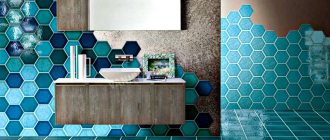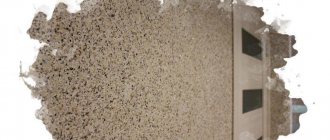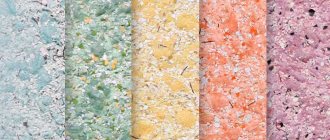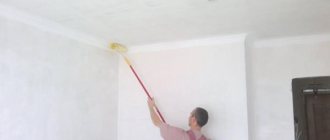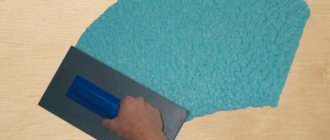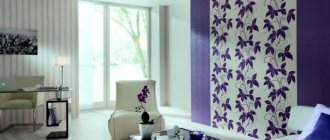Sometimes people are faced with the problem of whether it is possible to apply liquid wallpaper to paint.
It must be understood that the finished old surfaces of the walls inside the premises are ultimately the final finishing of the enclosing structures. The main purpose of the cladding is to give the walls a beautiful appearance and at the same time be protection from negative external influences.
On what surface can a new lining of liquid wallpaper be applied if the wall was previously covered? Painted wall surfaces have low adhesion and cannot create a strong bond with the new coating.
What is liquid wallpaper
First, let's define what liquid wallpaper is in order to understand what conditions must be in order for it to stick well to the wall.
By and large, liquid wallpaper is a special powder that, when interacting with water, forms a special paste, which must be spread over the walls using a roller and given time to dry.
Based on this, liquid wallpaper can stick to any surface. However, the catch is that the surface itself must be reliable.
If you apply liquid wallpaper over old wallpaper, it will stick. However, if the old wallpaper is not securely glued to the walls, it will fall off and your liquid wallpaper along with it.
In this situation, we can conclude that when applying liquid wallpaper to the walls, it is advisable to get rid of the old decor. It is desirable, but in the case of paint it is not necessary.
Pros of painting
There are no special types of paint for liquid wallpaper. Manufacturers believe that this coating does not need to be painted. But if desired, use paints used for other types of wallpaper. It is only important to decide whether it is really necessary. When deciding to apply paint to the surface of liquid wallpaper, you must first become familiar with the main advantages and disadvantages of painting. The advantages include:
- if liquid wallpaper was applied a long time ago and has lost its original appearance, painting will be the best option. With its help you can easily get rid of coating contaminants without investing a lot of money;
- With the help of painting they quickly update the interior. If you are already tired of the appearance of the wallpaper or there is a need to change the design of the room, paint will be simply irreplaceable;
- the surface can be repainted an unlimited number of times without harm to the coating. The main thing is to carefully follow all instructions when working;
- The variety of colors and shades is also an undoubted advantage of painting. In this case, colored paint must be purchased at the store. It is also possible to purchase a color scheme and select the desired shade yourself;
- It should also be noted that this work is not too complicated and will not take much time. Even a novice master can handle it, and the price of tools and material is quite low.
How to properly prepare painted walls for liquid wallpaper
So, if your old paint is peeling off, then undoubtedly you need to get rid of it first in order to eventually begin applying liquid wallpaper to the walls. In general, if it is possible to get rid of old paint, then it is advisable to get rid of it.
Now let's take a step-by-step look at what to do with painted walls if the paint sits well on them and is difficult to dismantle.
- First of all, the walls must be impregnated with concrete contact or other strong primer. Take an ordinary roller and coat all the walls with the solution, without missing any pieces. Pay close attention to corners and other difficult spots in your room.
- Next, you need to give the concrete contact time to do its job and dry. Apply liquid wallpaper only to dry walls, so don’t rush.
That's all the steps to prepare painted walls for applying liquid wallpaper.
Of course, we repeat, if the paint does not sit securely on the walls, you need to get rid of it.
Ways to remove old paint
Old paint can be removed with an abrasive wheel.
There are several ways to remove old paint. Let's reflect this in the table:
| № | Type of paint | Removal methods |
| 1 | Oily | Burning, rinsing with solvent, cleaning with an abrasive wheel |
| 2 | Acrylic | Wetting with water and scraping off paint with a spatula, cleaning with a spatula |
| 3 | Water-based | Same |
| 4 | Pentaphthalic | Burning, rinsing with solvent, cleaning with an abrasive wheel |
Burning with an open flame is carried out using a gas torch or blowtorch.
The old cladding is washed off with a brush dipped in solvent. The abrasive wheel is installed in the drill chuck. To learn how to remove old paint from a wall, watch this useful video:
Such work involves the use of open fire and the release of harmful fumes, so it is necessary to use personal protective equipment. There should be no unnecessary objects in the room that could catch fire, and ventilation of the entire interior space of the room should be provided.
Is it possible to apply liquid wallpaper to paint without preparation?
No, liquid wallpaper cannot be applied to painted walls without preparation. Perhaps in your case everything will be successful and such repairs will serve you faithfully for many years. However, it is possible that the money spent on expensive liquid wallpaper and the effort invested will not live up to expectations, since under the weight of the wallpaper, the paint will begin to fall off over time and you will have to redo everything.
- The primer creates the right layer with good adhesion, which prevents your wallpaper from coming off the walls.
- Concrete contact, unlike a conventional primer, also penetrates into the paint itself, thereby loosening it and forming a good basis for applying any decor, including heavy ones. This surface has excellent adhesion and the wallpaper will stick to it very well.
If you respect your time, then don't experiment. Better do everything according to our advice.
Application to various surfaces
Which surface can liquid wallpaper be applied to in order to get the best result? The answer is almost any. Therefore, further we will consider options for working with different wallpaper bases.
Drywall
The plasterboard surface is ideal for this coating; its structure is perfectly compatible with the liquid composition. Therefore, wallpaper applied to drywall will adhere and look good. But drywall, like other surfaces, needs to be prepared: primed, leveled the surface and applied a thin layer of plaster to it, which is then sanded. Next, a primer is applied, and if there are dark spots, the surface is painted with white paint so that they do not show through the coating. Before starting work, the wallpaper mixture is mixed again, applied to a spatula and applied to the surface with progressive movements. The layer should be thin, about a millimeter or two thick. It is advisable to go through one wall in one go.
OSB boards
Since the protective layer of OSB does not allow the use of various liquid materials on it without preparation, it is necessary to remove it with a sanding machine before applying the wallpaper, you need to cover the surface with an acrylic primer, level the joining areas with putty, sand it and apply a final layer of primer on the concrete.
Plywood
Before work, you should check that the plywood is securely fastened to the wall. To prevent plywood sheets from deforming under the influence of moisture, they should not be too thin. The wall is primed, and the untreated surface is covered with primer in 2-3 layers. Just like on other materials, if necessary, you should paint the wall with white paint
Oil paint will not allow the surface to “breathe”, and thus will remove this positive effect from using liquid wallpaper.
Emulsion paint
It is not advisable to apply wallpaper to old water-based paint; it is better to get rid of this coating by washing the walls with warm water, and then cover it with a primer and light paint.
Conclusions on the topic
Thus, we discussed the topic of applying liquid wallpaper to painted walls and came to the following conclusions.
- To decorate walls with liquid wallpaper, it is advisable to get rid of old decor, including paint.
- If the paint adheres confidently to the walls, then it can be covered with concrete contact and liquid wallpaper applied on top.
- You cannot apply liquid wallpaper to painted walls without preparation.
It is worth understanding that liquid wallpaper itself is not a cheap decor, so you should not skimp on preparatory work once you have decided to buy liquid wallpaper.
If you still have questions after reading the material, write to us in the comments under this article and our readers or authors will definitely answer you.
Happy renovation!
Finishing process
The ability of liquid wallpaper to adhere well to walls painted with water-based paint makes it a universal material for quick cosmetic repairs. These wall coverings are just as easy to apply over putty and plaster.
There is no big difference between applying wallpaper to paint or a clean wall:
- The material is sold in dry packages. According to the instructions on the package, you need to dilute the mixture with water and stir until smooth. You can mix with your hands - high-quality products have a non-toxic composition and are not capable of harming the skin.
- First, additional ingredients (mica or glitter) are poured into a special bowl with water. The water should be at room temperature for optimal reaction time. After mixing, the remaining ingredients are added to the mixture.
- The composition should “ripen” in the bag for another 12 hours after adding water.
- After this time, you can begin installation. To do this, use a metal trowel. The mixture is laid out in a layer of 1.5 - 2 mm, positioning the tool at an angle of approximately 20 degrees.
- After applying the mass, it must be stretched along the wall until the most even layer is achieved.
- The resulting surface is left to dry. In this way, liquid wallpaper applied to paint is obtained.
Application of liquid wallpaper
When the cleaned surface is prepared, the primer is completely dry, you can apply liquid wallpaper. Depending on their consistency and type, tools such as a trowel, spatula or roller are used for work. It is most convenient to work with a trowel - a little mixture is applied to it with a spatula, which is then evenly distributed and leveled on the wall. If the mixture is more liquid, then you can use a roller.
After such repairs, in compliance with all technologies, the walls will be smooth and neat. Over time, if you want to change the design of the room, the liquid wallpaper can be painted in any color. You can even glue regular wallpaper on them. Just first prime the entire surface with wallpaper glue and let it dry completely.
Source
What to do if paint cannot be removed
The presence of old materials under the layer of liquid wallpaper can impair adhesion. Dirty spots and peeling paint will not allow liquid wallpaper to reliably adhere to the surface.
There are cases when liquid wallpaper was applied to paint, but this required special preparation. This process takes much less time than completely removing the old finishing material.
You need to start preparing with a thorough examination of the surface. Damaged and stained areas will still have to be removed. A spatula or scraper is suitable for this. Paint that is too strong can be left on.
The resulting irregularities will be hidden under a layer of new coating. It is important that the recesses on the wall do not exceed 0.5 cm. Deeper flaws will have to be puttied.
Interesting! This method of carrying out cosmetic repairs is only possible if the house has perfectly smooth walls with no additional recesses.
If the surface to be finished with this mixture is painted with paint with a pronounced glossy effect, then the wall is subject to special treatment. Wallpaper is applied only after the surface becomes rough.
For this you can use:
You don't have to put a lot of effort into this procedure. It is enough to achieve light, uniform unevenness and remove the gloss. This method will ensure the best adhesion of surfaces and a more lasting effect.
A primer must be applied between the paint and the wallpaper. It is desirable that the composition be distinguished by the ability of deep penetration. After complete drying, you can proceed to the procedure for applying liquid wallpaper.

